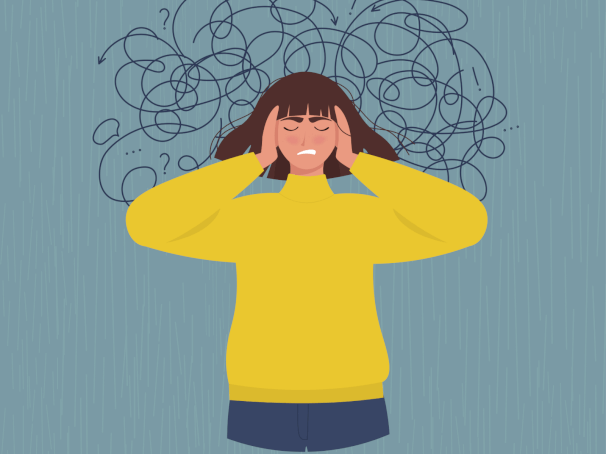
An anxiety disorder is diagnosed when normal, anxious feelings begin to disrupt normal life. This can happen for a wide variety of reasons and cause many different symptoms, which, from a diagnostic viewpoint, translates into many different types of anxiety disorders.
This article will provide an overview of the different categories of anxiety disorder as listed by the Diagnostic and Statistical Manual of Mental Disorders or DSM-IV (a comprehensive source for information on mental illnesses published by the American Psychiatric Association). It will also describe their usual causes, as well as the signs and symptoms that lead to a diagnosis of each.
Different Types of Anxiety disorders
There are many different types of anxiety disorders. Only a trained professional (MD or a licensed psychologist) is allowed to diagnose your disorder. You should also note that even if you don't suffer from a diagnosable anxiety disorder, it may still be worth getting help.
Acute Stress Disorder
Acute stress disorder is related directly to post-traumatic stress disorder. Originally, you had to suffer from PTSD for 30 days before you could be diagnosed. ASD, on the other hand, can be diagnosed immediately and refers to the first 30 days you suffer from PTSD-like symptoms.
Acute stress begins as a natural reaction to a situation that causes you to feel extreme helplessness: namely, a situation in which you are witness to or are experiencing a threat or actual event of serious injury or death.
Within four weeks of the traumatic situation occurring, one of more of the following symptoms must occur for a duration of 2 days at minimum and four weeks at maximum for a diagnosis of acute stress disorder to be made:
- flashbacks - in which the acute stress reaction is repeatedly and intensely relived due to encounters with stimuli that call the traumatic situation to mind (either during waking hours or in dreams),
- conscious or unconscious avoidance of contact with stimuli that have any relation to the traumatic event,
- perception that the world around you has become unreal (also known as derealization)
- emotional numbness and detachment
- difficulty sleeping which may result in tiredness and frustration or irritation with relatively unimportant things.
However, when these symptoms last for more than four weeks, the diagnosis shifts from acute stress disorder to post-traumatic stress disorder (PTSD).
Agoraphobia
Agoraphobia, which is Greek for fear of a gathering place, is an anxiety disorder that can have a variety of causes, including traumatic experiences, phobias, or frequent panic attacks.
Agoraphobia is marked by a fear of different types of spaces, and/or an unwillingness to leave spaces perceived as safe (such as the home). When in the type of space that causes the anxiety, it is usually marked by an irrational feeling or perception of being out of control or in danger. The types of spaces that may cause anxiety include crowded areas, vast, empty areas, unfamiliar environments or travelling compartments (such as a car, bus, boat or plane).
An unwillingness to leave the home usually only results in extreme cases. However, regular panic attacks in these types of space and/or an avoidance of these spaces for the reasons noted above are usually enough to diagnose agoraphobia. It is often associated with a panic disorder.
Generalized Anxiety Disorder [GAD]
It is still not well understood why generalized anxiety disorder occurs. It may have to do with the changes in brain chemistry that can be caused by long term environmental stress (such as the decrease of serotonin or happy chemical receptors with an increase in epinephrine or worry receptors), with similar changes that can occur due to other psychological disorders (such as depression), or with having a predisposition (either genetic or perhaps simply stressful childhood-related).
This disorder is characterized by excessive and uncontrollable anxiety triggered by environmental factors including school, work, or home life, and exacerbated by the physical effects of the anxiety itself including irritability, edginess, bodily tension, chest aches and tension headaches, difficulty sleeping, and resulting tiredness.
If the above symptoms persist with regularity over a period of at least 6 months (even if a day here and there is symptom-free or close to it), disrupting your functionality and the rhythms of your life, you are considered to have generalized anxiety disorder.
Obsessive-Compulsive Disorder [OCD]
Evolutionary psychology suggests that the development of OCD as a disorder may have been due to evolutionary advantages. The compulsion to clean and closely monitor oneself and one's home may have been beneficial in preventing disease, sickness, and unexpected dangers. However, too much of this compulsion received through the genes can result in obsessive and unhealthy behavior, which is how the disorder may have come about. Compulsive behavior is thought to be due to a genetic mutation of the body's serotonin transporter gene - the gene that controls when and how much happiness is felt.
A combination of obsessive and compulsive symptoms is present in cases of OCD. Obsessions may be sexual, violent or religious in nature, or have to do with unwelcome and uncontrollable thoughts that lead to obsessive worry about otherwise unimportant things. Compulsions may include repetitive behaviors or rituals meant to calm their worries.
Panic Disorder
Panic disorder is a complicated anxiety disorder, the causes of which aren't entirely clear. While it has been shown to regularly reoccur within families, it is also a common accompanying condition to other conditions including depression and PTSD.
Panic attacks are the central symptom of a panic disorder. Panic attacks are periods of intense anxiety that involve the fight-or-flight reaction being triggered in the brain by environmental or mental stimuli that pose no realistic immediate threat. They result in symptoms like:
- Rapid heart rate
- Rapid breathing
- Shaking
- Sweating
- Flushing
- Chest pain
- Feelings of doom.
Though they are superficially similar to heart attacks, panic attacks generally do not result in physical collapse or death. However, they are often accompanied by the feeling that you are about to die. These are intensely physical events that can occur out of the blue.
You may also be diagnosed with panic disorder if you fear panic attacks on a regular basis in a way that affects your behavior, even if you do not experience further panic attacks.
A failure to treat panic disorder may result in fears about losing control over the body and mind in public spaces, which can ultimately lead to a refusal to leave the home and a diagnosis of agoraphobia. Panic attacks are very hard to control without help.
Specific Phobias
Phobias are specific, irrational fears. To qualify for a phobia, these fears need to be strong enough that they affect your daily life in some way.
In some cases phobias can be a response to traumatic events, though you may not always be aware of the traumatic event that resulted in your phobia. This is because it may have been based on traumatic events as far back as childhood that your conscious mind can no longer remember. It is also possible that you did not experience the "trauma." Rather, as a child, you may have witnessed someone else showing this type of fear, which in turn caused you to develop the fear.
When phobias - the avoidance of the object of your irrational fear or extreme reactions produced by contact with the object - disrupt your daily living and cause unnecessary problems (i.e., feeling the need to move out of your house after seeing a harmless garden spider on the floor, or never going out because talking to other people makes you nervous), you may need medical attention.
It should be noted that simply being nervous around spiders or in social situations isn't enough: to be diagnosed with a disorder, your phobia must have the potential to interfere with your social and/or work life to a damaging degree.
Post-Traumatic Stress Disorder [PTSD]
Post-traumatic stress disorder, like panic disorder, is caused by high stress situations in which the threat of physical violence (including sexual assault) or death is present, accompanied by an intense feeling of helplessness. Women are more likely to experience PTSD than men, and adults more likely to experience PTSD than children over 6, though extremely high stress situations are obviously equally possible for men, women and children. There is some evidence that susceptibility to PTSD may be hereditary.
Unlike panic disorder, PTSD has a known cause - namely, the experience of a trauma, like a sexual assault, a car accident, a war, etc. You can also get PTSD from witnessing an event, and in rare cases develop it when you hear of an event from someone else or see the aftermath.
This disorder is diagnosed by the presence of symptoms that persist for over four weeks including intense and repeated flashbacks (either while awake or while asleep) of the event, a perceived inability to discuss the event and an avoidance of any reminders of it, emotional numbness, and the belief that life has been irrevocably tainted by the experience, resulting in social and work-related problems that did not exist before. You may also exhibit an increased startle reflex and it may be easier for you to experience high anxiety or fear after only a mild stressor.
In children, PTSD is also marked by displays of disorganized and agitated behavior at the time of their exposure to the traumatic event.
Social Phobia
Social phobia is technically a phobia, but it is considered a separate disorder because of the way it impacts a person's life and the fears that are present. Social phobia is directly related to shyness, but mild shyness - and even moderate shyness - is not usually considered to be social phobia.
Those who are social phobic have an intense fear of embarrassment. They are extremely uncomfortable around others, and often struggle to make friends or be in environments where they have to speak. They often see negative emotions in others even when they're not there, and will actively avoid any situation where they may be expected to speak.
Diagnosis is usually at the doctor’s discretion, but in some cases social phobia and shyness can always benefit from some form of treatment.
What to Do Next?
If you fit any of the above profiles, the feelings you have been dismissing as a weird personality quirk or just the result of a hectic modern life may actually be something more serious. Consulting with your doctor or therapist will provide you with an official diagnosis. You cannot be diagnosed without talking to a doctor or psychologist, because there are issues at play that affect diagnoses. All diagnoses are based on the DSM-V, the diagnostic manual used to determine disorders.
Fortunately, all of these disorders are treatable. With time and persistence you can retrain your mind to stop causing you undue anxiety and start living your life the way you want to live it.











